This Tartine style no knead Whole Wheat Sourdough Bread recipe is wonderfully nutritious and delicious. The long cold rise aids the fermentation of the dough and improves digestibility, making it a great choice for many. Sourdough also contains higher amounts of vitamins, minerals and antioxidants that commercial breads.
With our tips you will have great success in baking Whole Wheat Sourdough Bread using either white or red wheat berries.
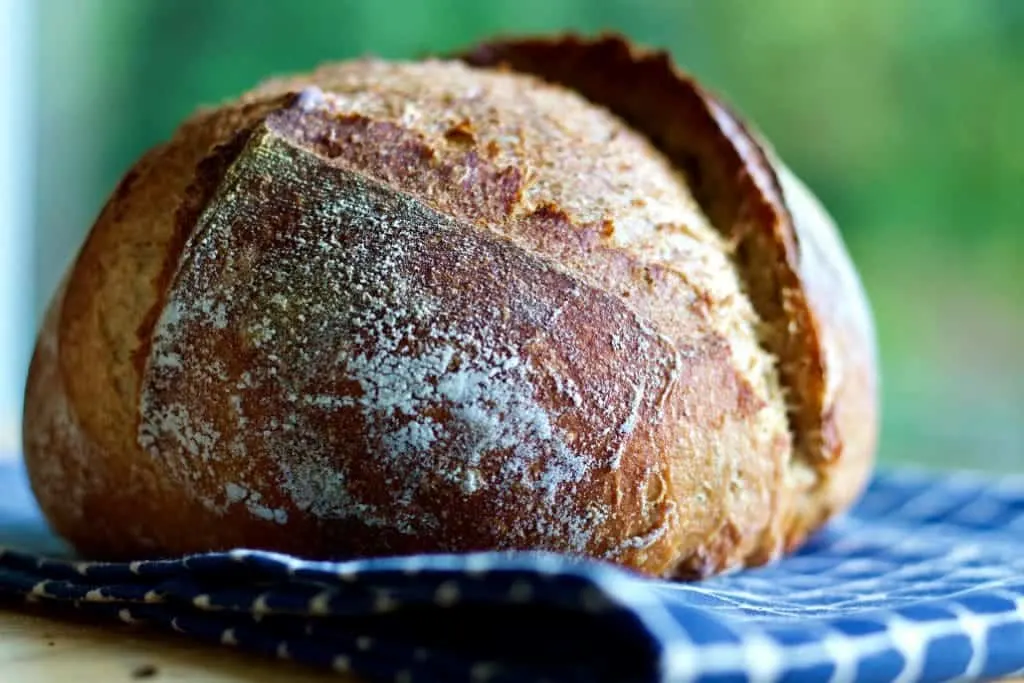
How does Whole Wheat affect Sourdough?
Using whole wheat flour will add more flavor, fiber and protein to your bread loaves. The color will be noticeably darker and the structure may become a bit denser, but won’t negatively affect the crumb of your loaf.
Some folks prefer the flavor that whole wheat brings, as it will increase the nuttiness and richness of the bread. Others prefer only adding a percentage of whole wheat flour into the dough, rather than making a fully whole wheat dough.
Technique Video
The video shows you the techniques used in making the tartine style sourdough recipe and every step in order. The video dough is not a whole wheat flour bread but it a great technique video for all sourdough breads.
It’s all the same process for the Whole Wheat Sourdough Bread method, except for the slap and fold method which is described further down this post.
This white whole wheat loaf is beautiful with a nice amount of rise, moist flavorful crumb and it’s extremely nutritious.
More Homemade Food Junkie Sourdough Bread Recipes you may enjoy. Just click the link at the bottom of the picture to open a new recipe.
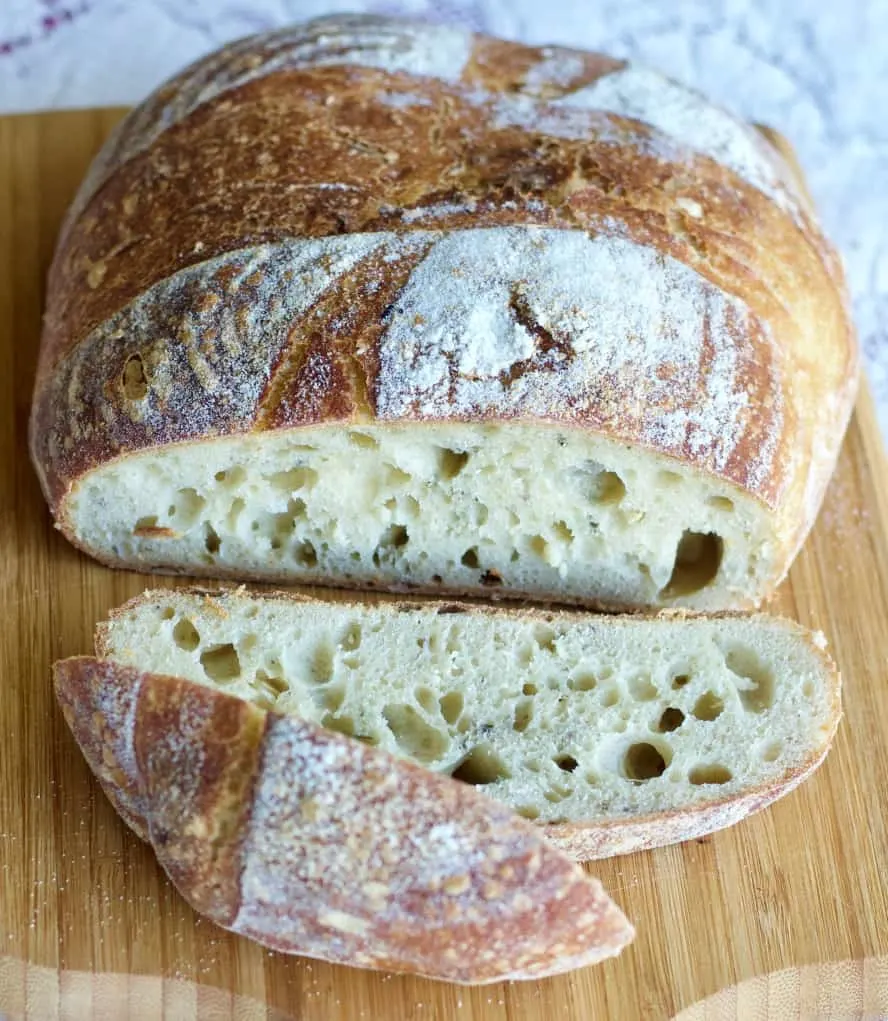
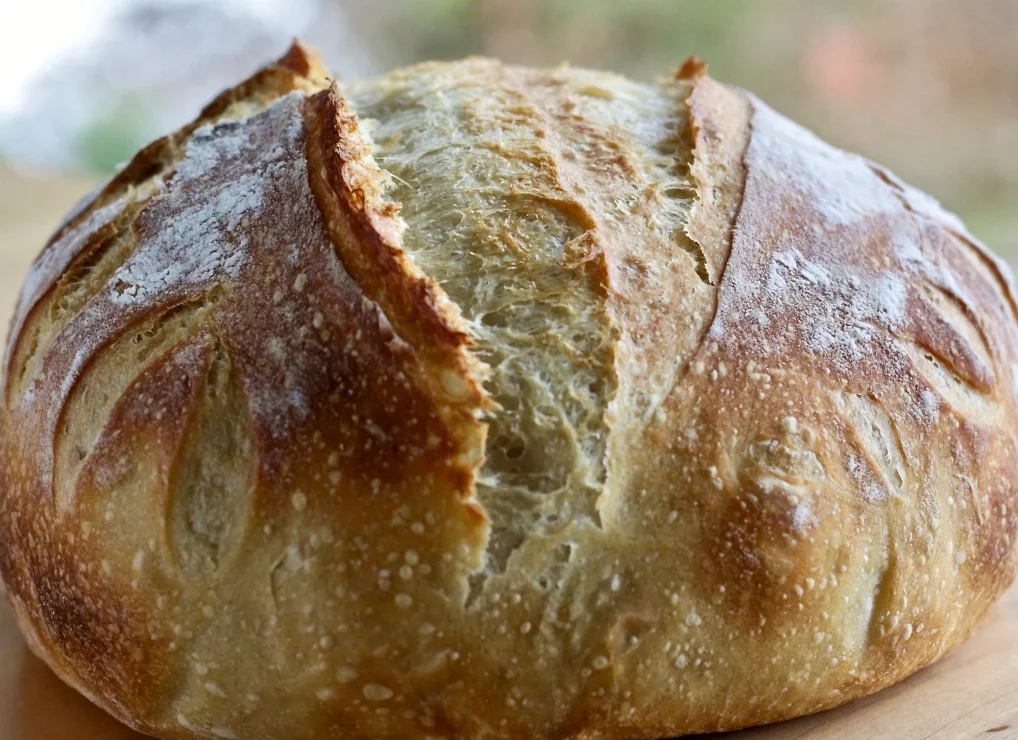
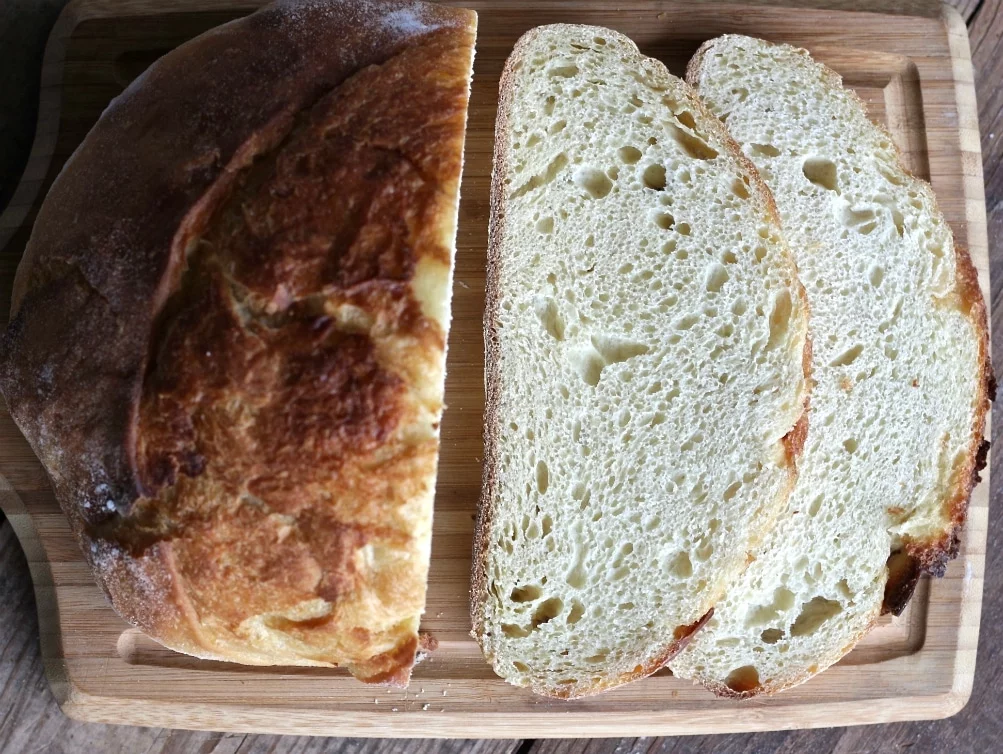
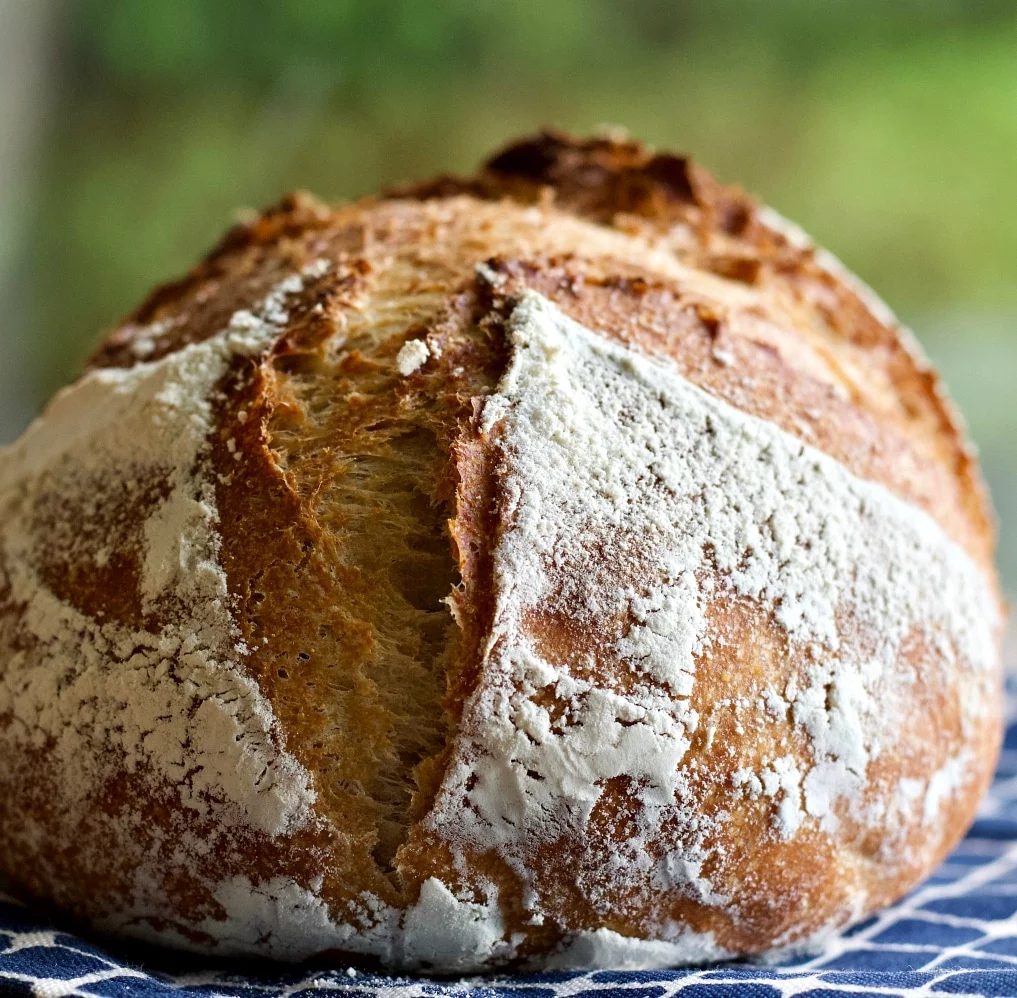
What is the healthiest Sourdough Bread to eat?
Sourdough bread itself is a very healthy bread made with minimal ingredients and containing a lower gluten level than most breads. For an even healthier sourdough bread choose one made with a combination of white and whole wheat flours.
The whole wheat flours will increase the protein levels, the fiber and the vitamins; while the white flour keeps the loaves lighter in texture and crumb. A sourdough loaf made entirely from whole wheat flour will be amazingly healthy, it just may be a bit more challenging to work with for beginner bakers, and it may present a slightly denser crumb than you prefer.
What is the difference in white or red Whole Wheat Flours?
White Whole Wheat Flour
- White whole wheat flour is a variety of 100 percent whole wheat. Just like any other whole wheat flour it is grown from wheat berries and made into whole wheat flour.
- White whole wheat flour is planted, grown and milled without extra steps or additives. No bleaching or mixing in other flours.
- It is exactly like brown whole wheat flour nutritionally.
- White is just a different color wheat and it can be easier to work with.
- The crumb of white whole wheat bread is dense compared to an all purpose bread flour but less dense than hard red berry whole wheat flours.
- White whole wheat flour makes baking with whole wheat flour easier. The crumb is about mid way between the lightness of all purpose bread flour and the heavier red winter wheat flours.
Montana Prairie Gold white whole wheat flour is a great way to lighten the whole wheat loaf and give it a softer, moister crumb.
White Whole Wheat Flour is simply naturally lighter in texture making it easier to work with. It’s full of the same nutrients classic red wheat flour has.
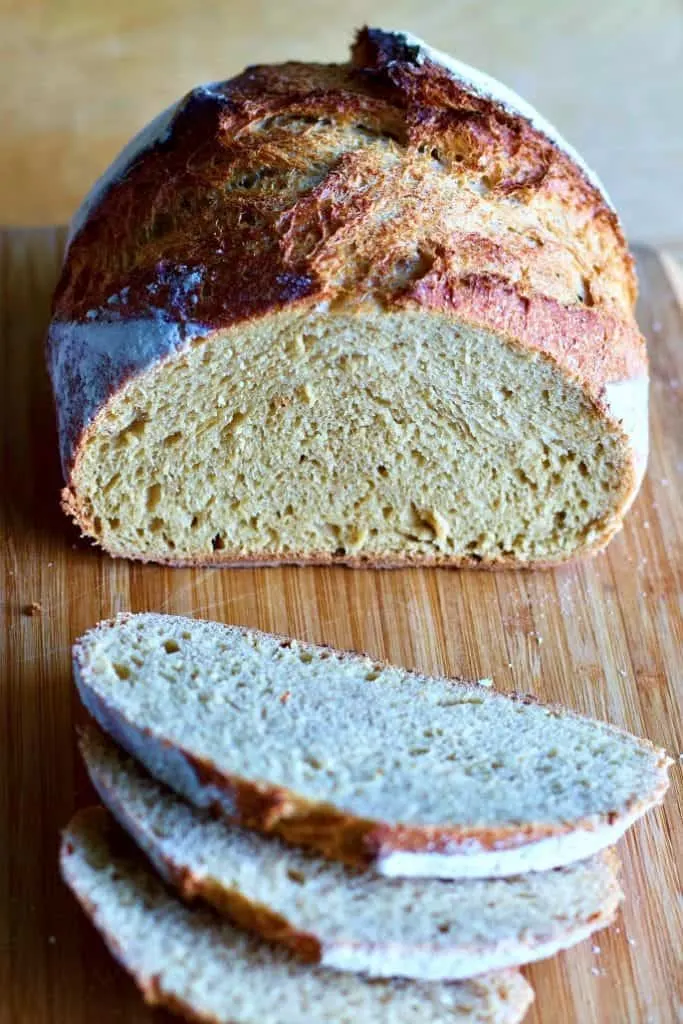
Red Whole Wheat Flour
Whole Wheat Flour made with hard red winter wheat berries is the most often used flour for whole wheat recipes. It is darker in color and can create a denser loaf of bread. Working with hard red winter berry whole wheat flour in a long rise sourdough bread is challenging.
- The heavier Whole Wheat Flours are stickier than all purpose white bread flours.
- They don’t develop gluten easily or raise as well as 100 percent white whole wheat sourdough bread, and will demand a longer rise time.
- Loaves will have a denser crumb and a stronger nuttier flavor.
- When making your own flour using red wheat berries we recommend setting your mill grain to the finest setting.

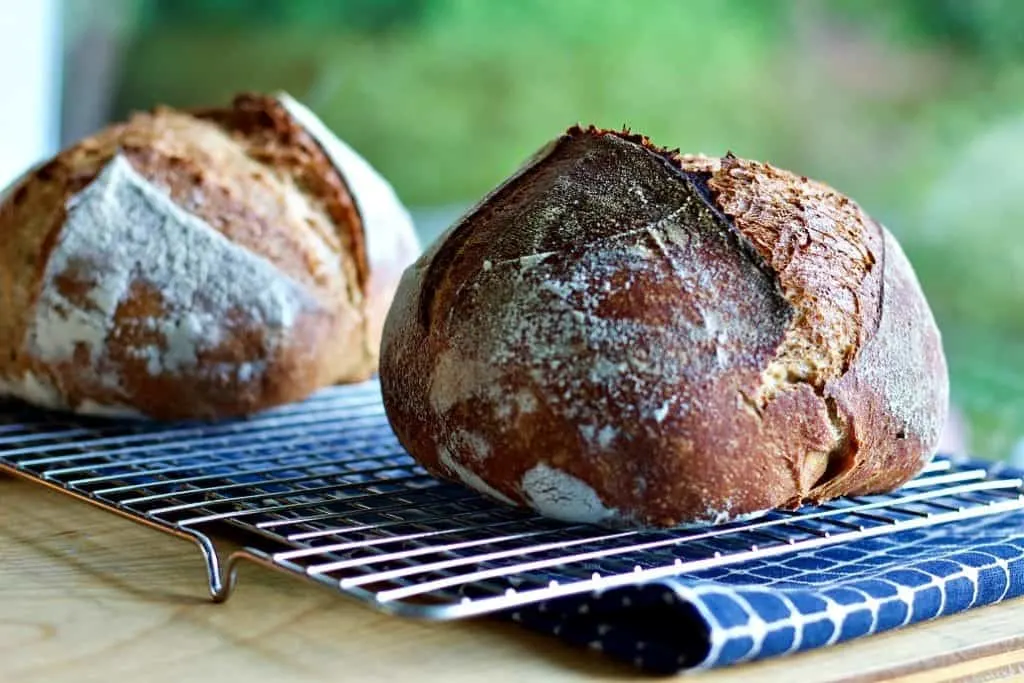
Whole Wheat Sourdough Bread Recipe
Now we know why white whole wheat flour is a good choice for the beginner artisan whole wheat bread baker. Let’s get started learning the method for this bread recipe. It’s very easy, it just takes some time.
TIP: Fresh milled flours offer the finest properties for baking. Whole wheat flours quickly go rancid, so use freshly milled flour for best results.
If you are a beginner we suggest you
- Start by watching the video to learn the techniques.
- Then read the printable recipe card to familiarize yourself with the method.
- Finally, read the tips you’ll find below. They are specific to this recipe. If you are still confused about something please feel free to ask us.
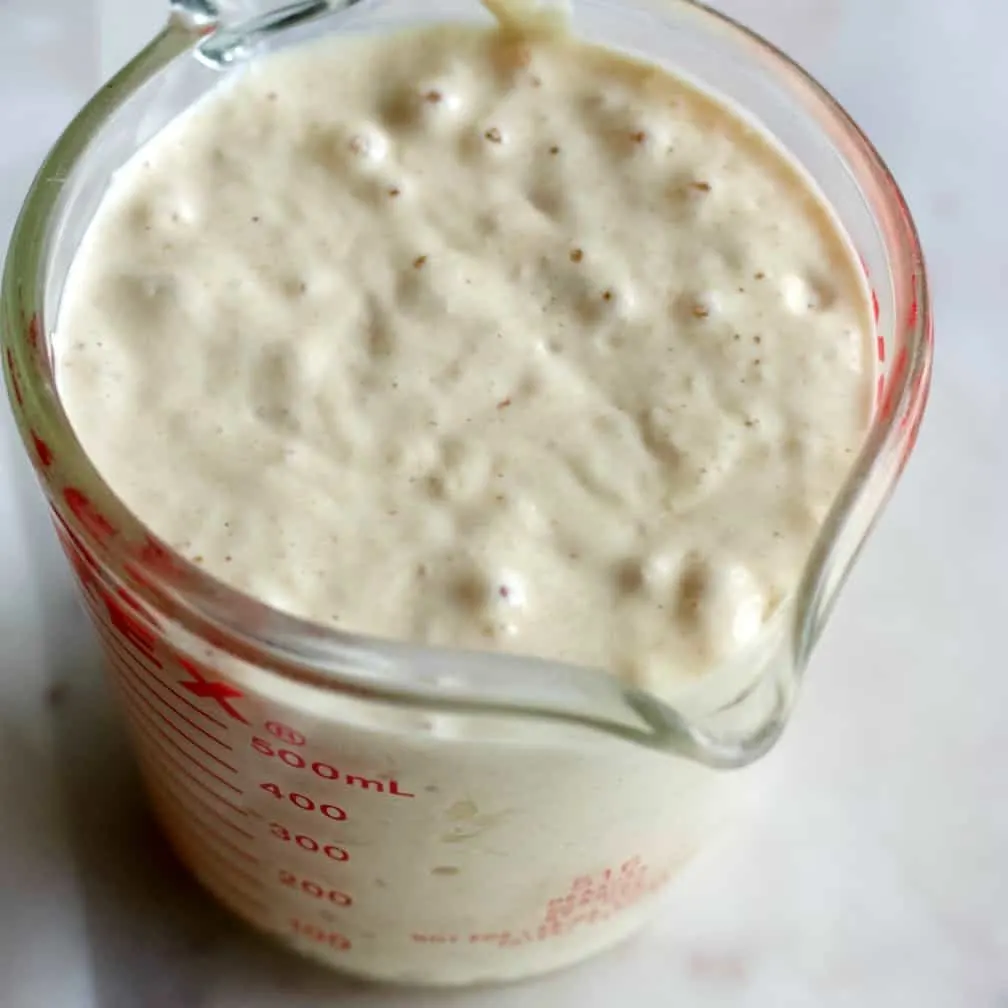
WILD YEAST STARTER
Wild yeast starters provide a much better, fuller, more complex flavor and texture compared to commercial yeasts. A good starter is crucial to your bread success.
Refer to this post on How To Make Wild Yeast Starter for more information and help if you need to make a starter from scratch. Dont want to make your own? buy it From our friend Sasha
- TIP: Do not begin your bread recipe until your active starter passes the float test.
- To float test your starter drop one teaspoonful into a cup of tepid water.
- It should bounce right up and retain its form.
- If you do have an inactive or lazy starter be sure to feed it.
- Feed it now and check it in a few hours then retest. That may be all it needs.
Feeding your Starter
The night before, or several hours before you begin your recipe, take your starter out of the fridge and feed it. I usually use 100 grams for the amounts I feed for this recipe. In equal amounts by weight. Mix together in a medium sized bowl.
- starter
- flour
- water
Let it sit at room temperature for several hours to overnight. It should pass the float test before using it for this recipe.
The Slap and Fold Technique
Using whole wheat flour will make the stretch and fold process a bit more difficult because the dough will be more resistant to stretching. This method will de-gass the dough somewhat which will give it the denser crumb you see pictured. However, it’s a great way to develop gluten for a sandwich bread that you want a close crumb on anyway.
- Pick up the dough with one hand and let it hang in the air until it stretches a bit.
- Slap it on the counter. It should be a stretched out piece of sticky dough.
- Release it from your counter with the dough blade and fold it over.
- Pick it back up by a different side and repeat until the dough has been counter slapped four times.
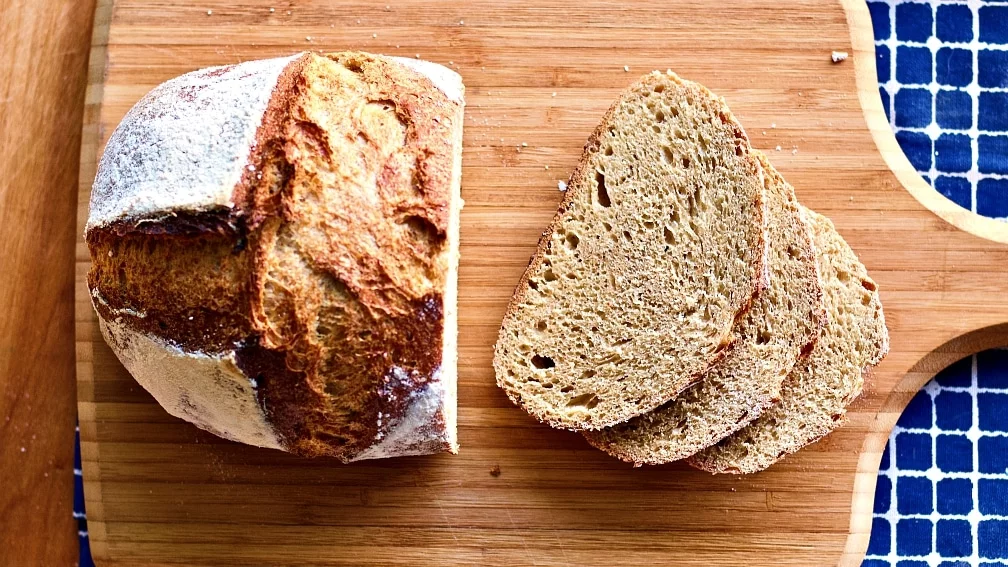
To achieve a lighter crumb
Beware too much liquid with the heavier red winter wheat flours. Start with 200 grams of starter and see if that works best for you. If it’s too dry add the extra starter after you have mixed it at the autolyse stage.
Stick to the gentler stretch and fold if you want a highly aerated loaf with lots of artisan like holes.
If the gluten does not develop and the dough is continuing to break after 4 folds add another stretch and fold until you get a stretchy dough. Adding more stretch and folds will help the gluten develop.
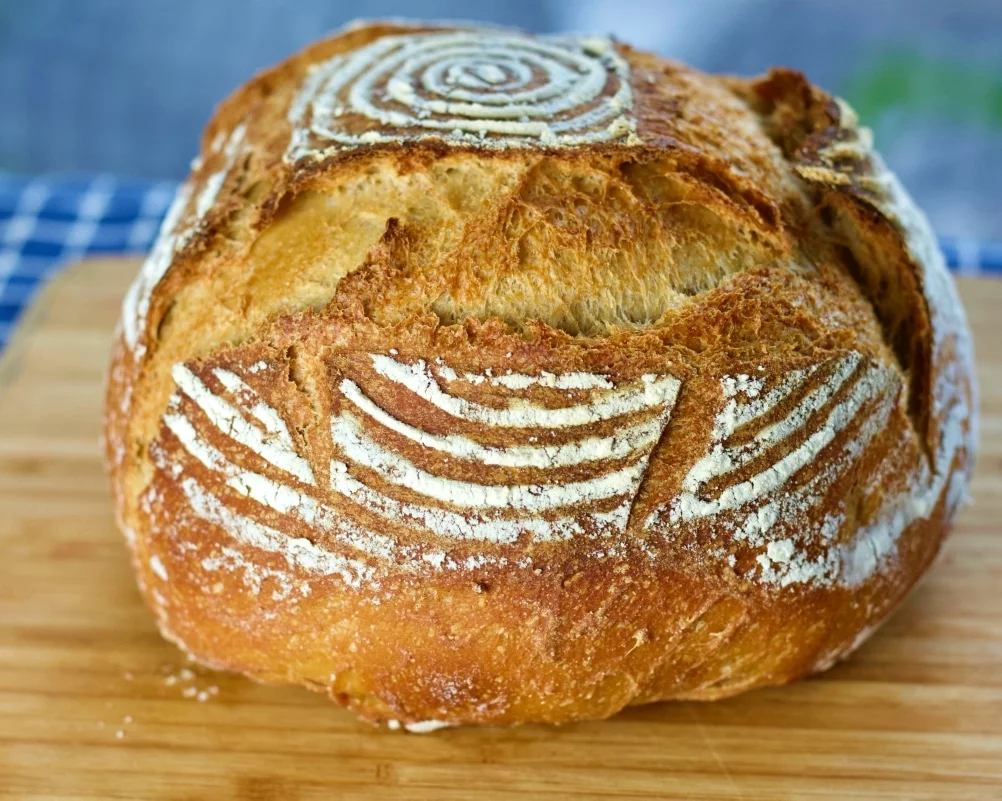
Scoring the loaves
Proper scoring helps the bread attain its optimal bread rise, which will give you the best crumb. It takes practice.
- When the oven and dutch oven are preheated remove the dough from the fridge.
- Set it on your parchment paper on the counter.
- Using a sharp lame or very sharp knife make deep grooves evenly around your boule.
- You can use any pattern you desire. The way you score the dough will determine its shape and lift to a large degree.
Helpful Suggestions
- Measure ingredients by weight. Flours especially need weight rather than volume measures for the most consistent results.
- We recommend a food scale like this G Dealer scale.
- You will need a dutch oven or other high heat oven safe skillet with a lid to bake your bread in. Chad Robertson prefers a Cast Iron Skillet Combo. A popular choice is the Le Creuset Oval Dutch Oven or a similar style.
- A good quality Dough Scraper Set is very helpful when working with high hydration doughs. The bowl scraper is genius. This is a sticky dough and the bowl scraper slides that dough around like a dream.
- Bannetons are for the final long rise often done in the fridge. They come with handy cloth liners that fit to help keep the dough well formed. The finished bread has lovely ridges in it. If you remove the cloth liners and heavily flour the baskets your loaf will look very artisan.
- A Lame Knife for scoring your loaves is also really helpful in releasing the dough to rise properly.
Your Printable Recipe card.
I suggest for this lengthy recipe you print out the recipe and refer back to it while reading the post tips.
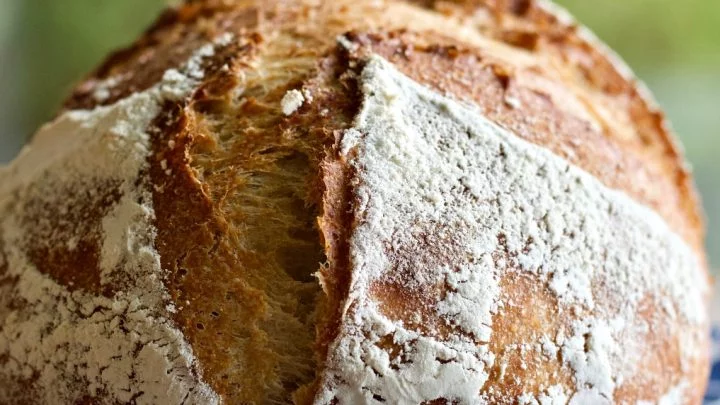
Beginner Sourdough Whole Wheat Artisan Bread
Make your own delicious bakery quality artisan sourdough breads at home. This recipe is a good start for new sourdough bakers. It's a long process but an easy one. These breads are so worth it!
Ingredients
- 525 grams water-80 degree F. -NO chlorine , 2.22 Cups
- 250 grams Very active starter - make sure it floats , 1 1/4 Cup
- 20 grams Sea salt , 1 Tablespoon
- 700 grams WHITE whole wheat Flour, about 5 1/2 Cups
Instructions
MAKE THE STARTER
- Make the STARTER AHEAD (This can take up to a week or more) AND DO NOT USE UNTIL IT IS ACTIVE ENOUGH TO FLOAT A TEASPOON ON A CUP OF WATER. Continue the recipe
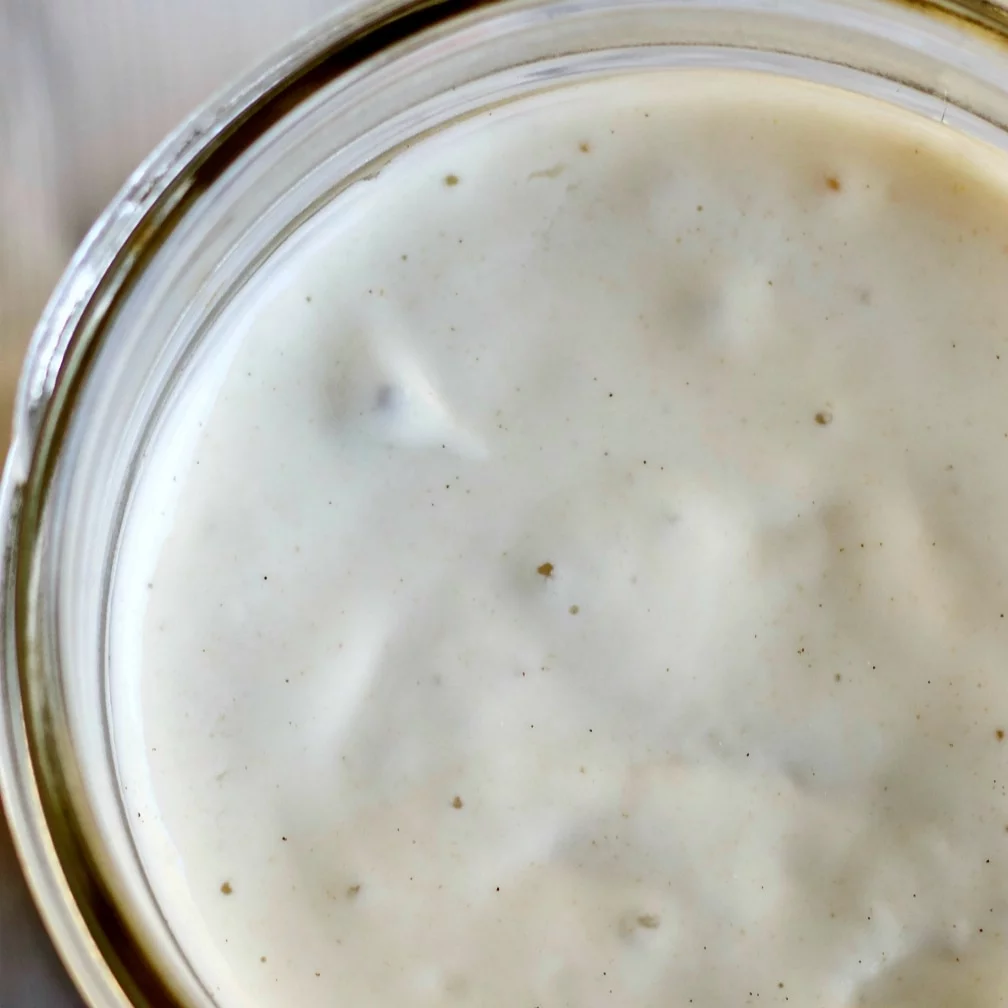
- Leaven Float Test
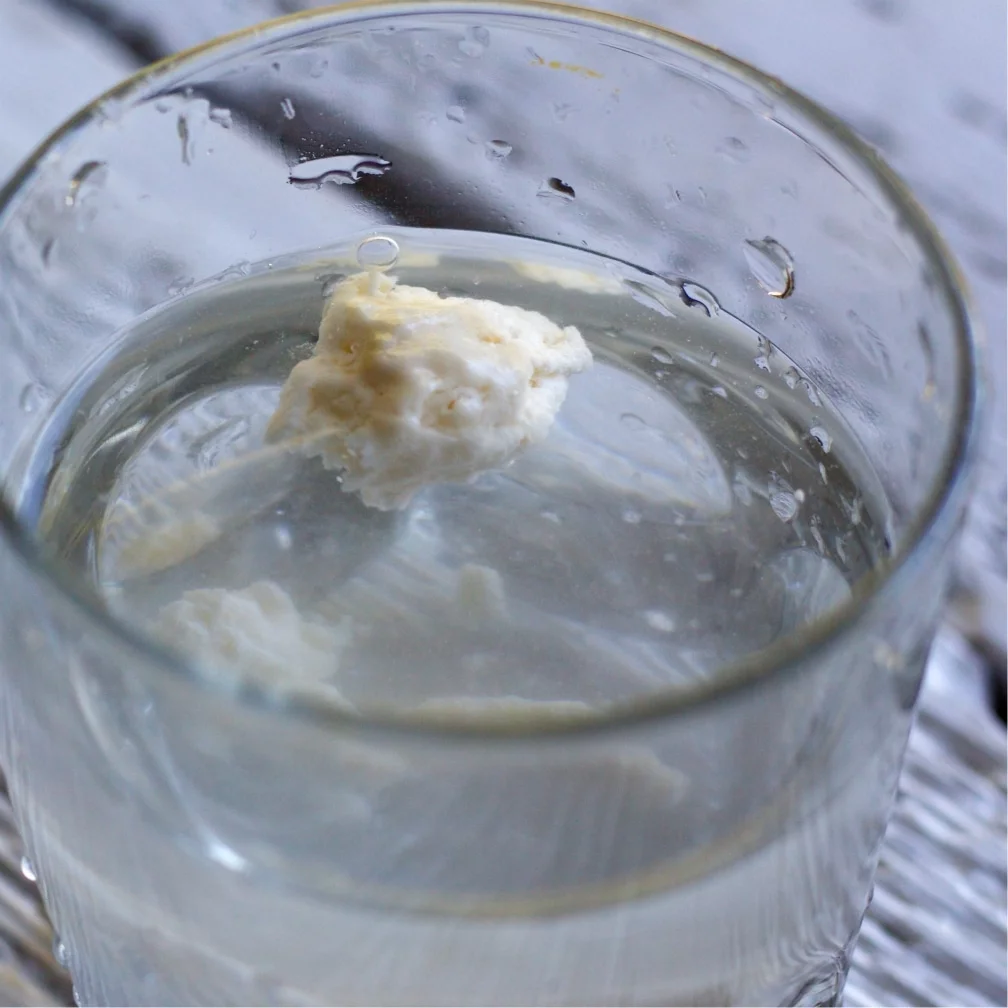
MAKE THE DOUGH
- Pour the water into a large bowl.
- Add the ripe starter to the water and mix thoroughly with a whisk or by hand until the floating cloud of starter is mixed completely into the water
- Add the flour to the leavened water and mix with the dough bowl scraper or other spatula. At the end use wet hands to form a shaggy dough ball.
AUTOLYSE
- Let it rest (autolyse stage) about an hour. This stage can be extended without worry up to four hours at 75 degrees F.
- After autolyse, add the salt to the bread dough. Use your hands to pinch and stretch the dough gently until the salt is mixed into the dough. (see video for my technique)
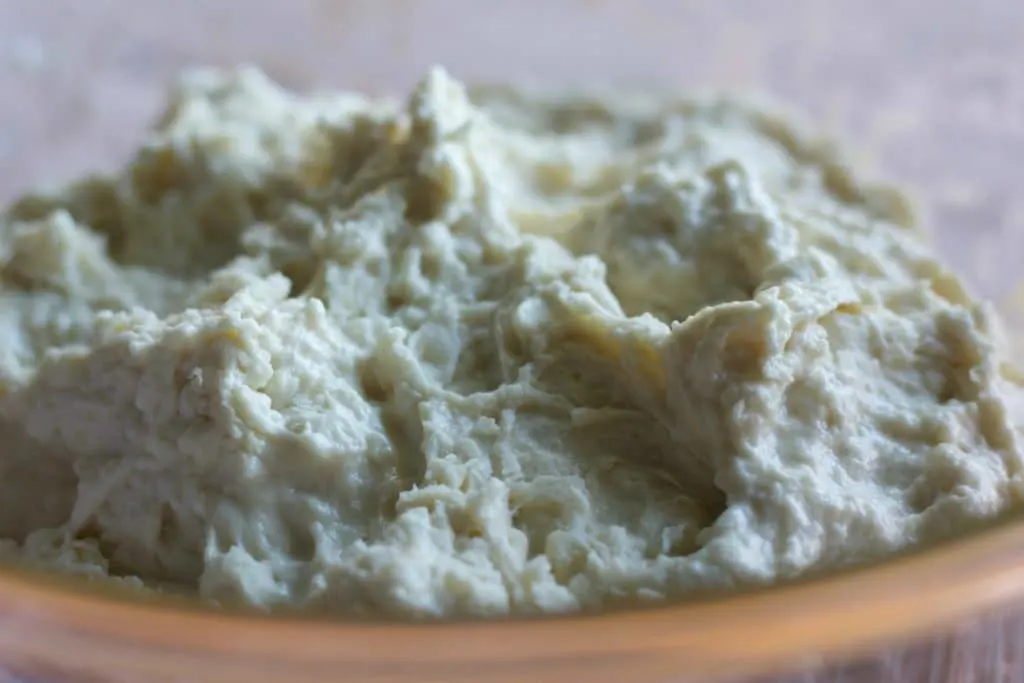
STRETCH AND FOLD (OR SLAP AND FOLD)
- Using your wet hands pull the dough from under the dough ball up and stretch it gently as you pull it over the dough ball top. Release. Repeat this process as you give the bowl quarter turns until the dough is stretched and pulled from each quarter of the bowl. (SEE video for a demo of this technique).
- Over the next 2 1/2 hours repeat the stretch and fold every 30 minutes. Whole wheat flour can be VERY resistant to this technique. If you prefer use the SLAP and FOLD technique.
- The dough should become an elastic resilient dough that passes the window pane test. BUT whole wheat flour may need more time in the stretch and fold(Or slap and fold) to build gluten sufficient to pass this test.
BULK RISE:
- Allow the dough to bulk rise IN THE BOWL at room temperature an hour or SO until it rises by 30 percent or so.
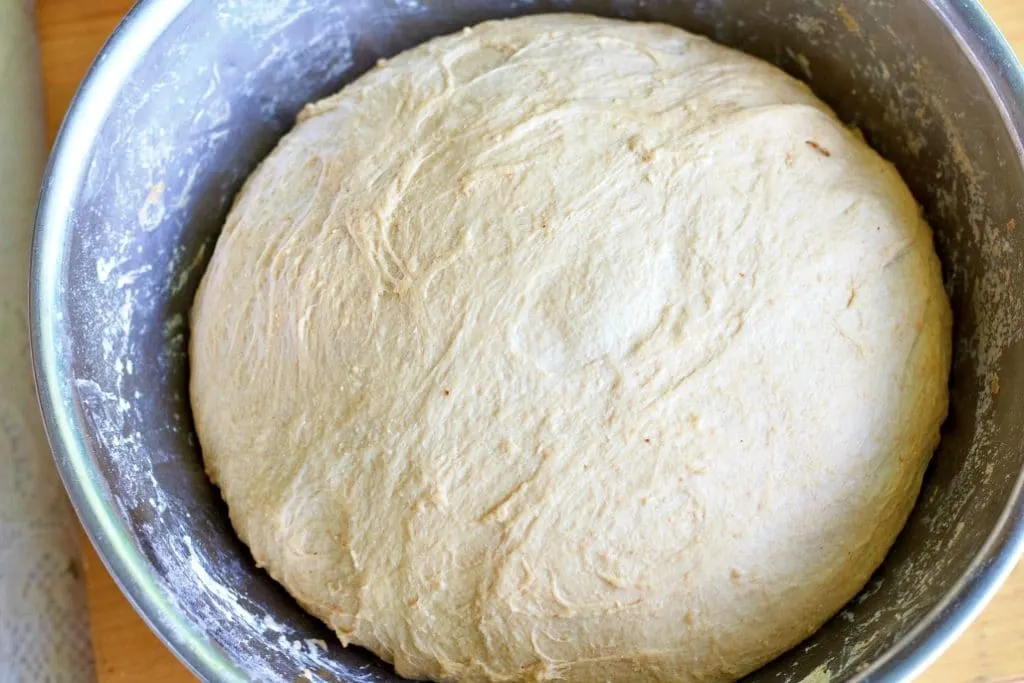
- Cover the bowl of dough with a plastic bag and set it in the fridge for 15 to 18 hours (Or overnight). It should continue to rise slowly so give it room in the bowl. Whole wheat flour will rise even more slowly than all purpose bread flours.
- Remove the dough from the fridge and let it sit on the counter in the bowl for two hours or until the dough reaches room temperature (or pretty close). The dough will soften and gently rise (a tiny bit) and relax as it warms.
DIVIDE AND BENCH REST THE DOUGH:
- On a clean unfloured counter pour out the dough into a large mass. Flour the top of the dough lightly but evenly.
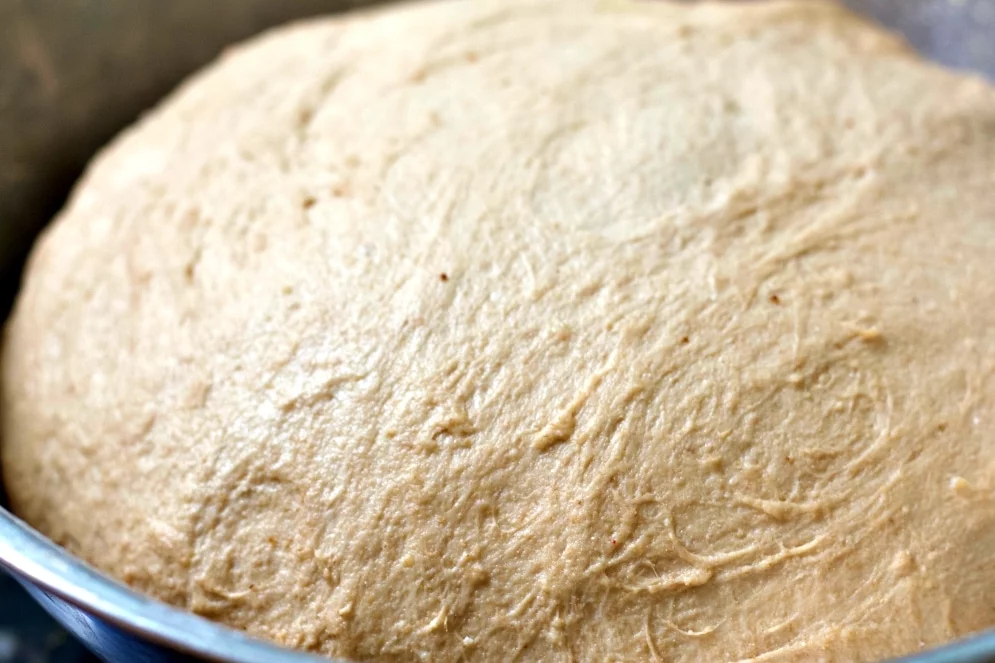
- Divide the dough mass in half with your metal dough scraper.
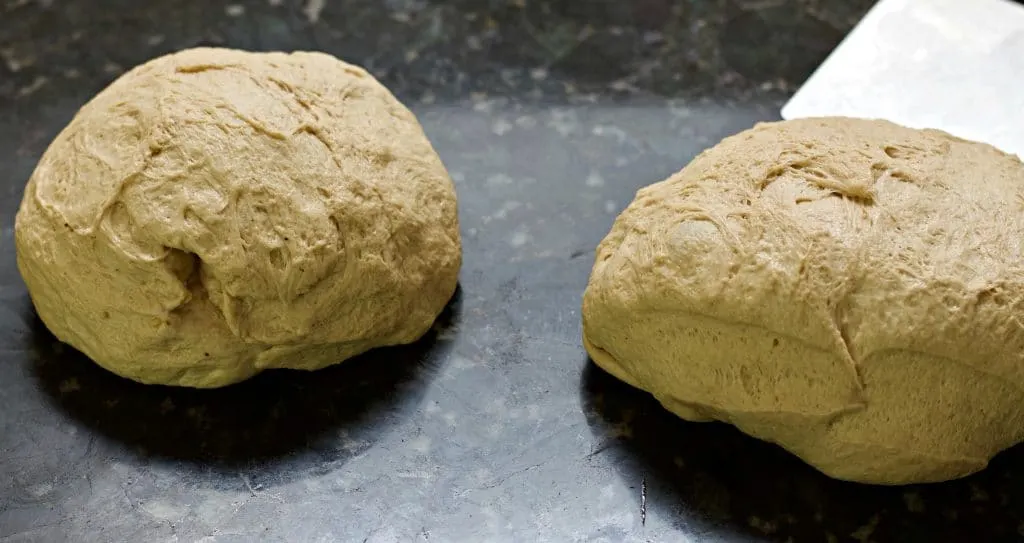
- BEING CAREFUL NOT TO OVERWORK THE DOUGH-Form each half into a dough ball. The most efficient way to do this is to use the counter as your pivot point. Scrape in a circle around the dough (leave it unturned, flour side up). The unfloured counter will hold the dough center and create tension as you circle the dough with the scraper forming a ball. Repeat to form two dough balls. The DOUGH edge should be round and the dough ball should have some form and resilience to it.
- Let the dough balls rest for 30 minutes or so. They will spread out but should not fall off at the edge of the pancake. If they do, reform the loaves and bench rest them again to build the structure of the dough better.
FINAL SHAPE AND RISE:
- Gently slide the dough scraper under one of your dough balls and flip it over so it rests on the floured side.
- Now gently stretch and pull the dough over from the bottom to 1/3 up the loaf. Stretch and pull the dough from the sides to the dough middle. For the final stretch take the dough from the top of the ball and pull it all the way down to the bottom. Form a seam. Pinching the seam if necessary.
- Place the dough seam side up in your rice floured, cloth lined banneton or bowl.
- Rise in the fridge 2 to four hours until completely chilled. The loaves will not rise much at this point.
Baking Instructions:
- Set a baking stone (if you have one) on your oven bottom rack. Set your dutch oven with it's lid on next rack up (lower third of oven). PREHEAT oven to 450 degrees F. for at least 30 minutes.
- Keep the formed loaf in your banneton in the fridge until you actually need to place it in your preheated dutch oven. Cold dough will aide the oven spring. (which means the loaves will rise better).
- Remove one banneton from the fridge. Place the dough in your preheated dutch oven. Do this by flipping the loaf into the dutch oven as gently as possible seam side down. OR:
- Alternate method: Place high heat safe parchment paper over the banneton. Turn the banneton upside down so the dough falls gently onto the parchment paper.
SCORING THE LOAF:
- FOR OPTIMAL RISE: Score the loaf with your lame knife or a razor blade or sharp scissors. Scoring helps the dough rise better if you score the loaf at least an inch deep. And use cross cuts (The pound sign works well)
- Now pick up the scored loaf with the edges of the parchment paper, if using, and gently and carefully place it into your VERY hot dutch oven.
- Put the lid on the dutch oven and return it covered to your preheated oven.
- Bake 30 minutes at 450 degrees.
- Now REMOVE the lid (and parchment paper if using). Steam should come out. Hopefully the bread is a light golden color with a nice rise and set crust. Bake an additional 10 minutes UNCOVERED or until the loaf thumps hollowly and the surface gets dark(Caramelized darker than you are used to maybe) and the scored areas look shiny. (To prevent over browning turn the parchment paper (or foil) upside down over the loaf as it finishes in the oven.)
- Remove the dutch oven. Place the finished loaf on a cooling rack. Do NOT cut it for at least an hour to set the crumb.
- Return the dutch oven (with it's lid on) to the oven at 450 degrees F and preheat for 15 minutes. Repeat the process with the remaining loaf.
- To tell if your bread is properly done. It should sound hollow when thumped. The crust should look shiny and Caramelized at the scored sections. Whole wheat loafs are dense. The crumb may be open or closed depending on how you handled it.

Notes
WATCH your dough as it goes through the stages of fermentation.
This dough can easily over ferment at high room (Or oven proofing) temperatures. If your dough gets slack, unworkable and won't form or rise it is probably over fermented. At this point I suggest you Make pizza with it instead of loaf bread .To avoid over fermentation keep the room temperature (or oven) at 80 degrees or less. Whatever flour you are using will influence this process. Learn to work with the dough you are creating.
This bread freezes VERY well.
After it is completely cooled double wrap it tightly with plastic wrap and set in the freezer. Defrost at room temperature wrapped or unwrapped. Slice and eat.
For best results store your sourdough bread loaves in a bread box
(I use my dutch oven with the lid slightly cocked). That beautiful crunchy Sourdough crust gets soft in an airtight container or plastic sack. Once cut just set the bread cut side down to protect the crumb. These loaves hold very well for at least three days. Freeze the other finished loaf if you can't eat it right away.
Banneton Tips:
High Hydration dough tends TO STICK to the liner cloths and banneton ridges.
- Scrub rice flour (or cornmeal) into the cloth or banneton sides. Once the dough is in the banneton I add a bit more rice flour around the side of the loaf to keep it from sticking during the rise.
- IF your dough sticks a bit to the banneton cloth, use a sharp knife to pull it away and add some flour to the sticking spot. Now it should invert without too much trouble.
- For really tough sticks, cut the dough away from the cloth and repair it carefully by pressing the dough to reshape it before baking.
- Careful of burns if you are doing this in a hot pot.
- Don't despair. I have had some pretty mangled loaves come out of the oven beautifully!
Nutrition Information
Yield
20Serving Size
1Amount Per Serving Calories 112Total Fat 1gSaturated Fat 0gTrans Fat 0gUnsaturated Fat 0gCholesterol 0mgSodium 389mgCarbohydrates 24gFiber 4gSugar 0gProtein 4g
King Arthur Has more info on White Whole Wheat flours
Recommended Reference Books On Sourdough Bread Baking:
- Tartine By Chad Robertson
- Tartine 3 By Chad Robertson
- The Bread Baker’s Apprentice by Peter Reinhart
Follow Us:
We enjoy meeting you on our social networks. Follow us on Facebook, Pinterest, Instagram . Tag us with your pictures of our recipes and comment on how it went for you. We would love to see what you do with them.
We often like, comment and share your posts of our recipes on our daily Instagram stories.
Ask questions and rate the recipe in the comments section below. Please share what you did with this recipe. We are always looking for more and better ways to make homemade food. Other cooks love your ideas!
Recent Posts:
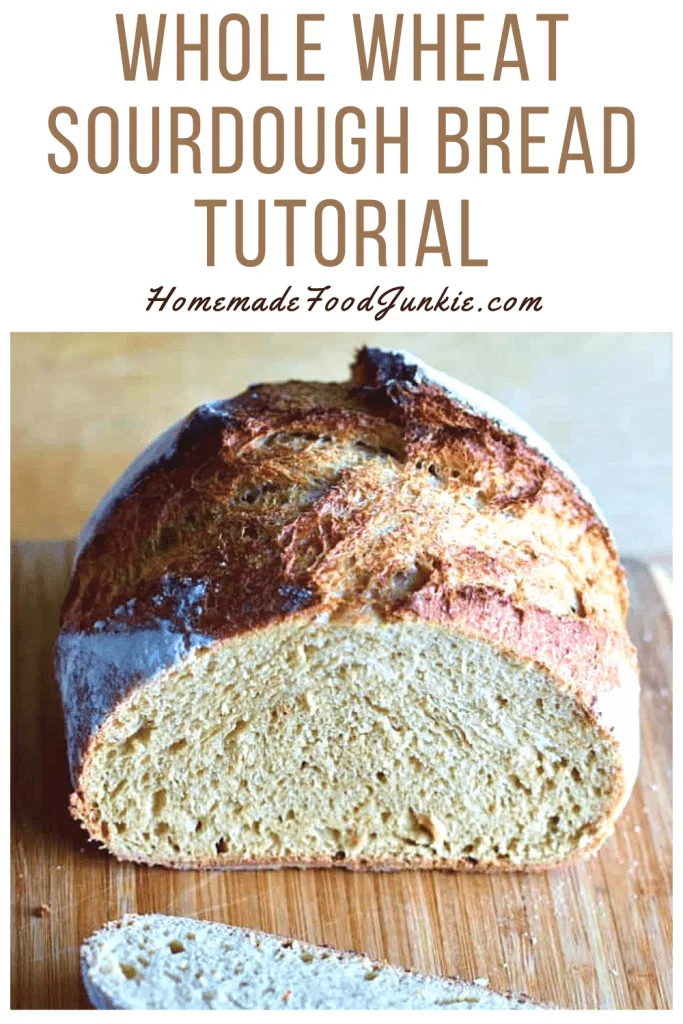

Dora
Saturday 18th of January 2025
Thank you for such a well explained recipe... I was wondering if sugar can be added to this recipe?
Diane
Sunday 19th of January 2025
Hi Dora, You can add sugar to this recipe it you like. A couple of tablespoons should give you some sweetness. Or honey would also work well. Happy Baking!
Kari Owens
Monday 17th of June 2024
I was totally happy once again with your recipe ! At first I was worried cause it was so sticky but within minutes of setting while waiting for the salt it started gettting its gluten ! I was super impressed with the dough and bread ! I used 370 of Kings white bread flour and 430 of kings whole wheat ! I was worried cause I didn’t have the white wheat flour so I pulled some of my wheat out after already dumping on top of the water and starter mix lol and added the amount according to how much I could pull out of the wheat .
Diane
Monday 17th of June 2024
Hi kari, Yay!! So happy you enjoyed this sourdough recipe. Whole wheat can be tricky. You are wise to use a high quality flour like King Arthur. The white whole wheat will work even better when you have it. Happy Baking!
Ann Huffman
Friday 16th of February 2024
if you do not have a batteton basket, do I need to do anything different?
Diane
Friday 16th of February 2024
Hi Ann, Any ceramic or stainless bowl of the proper size will work. You might want to add a little oil to the bowl to keep the dough from sticking. Happy Baking!
Deb Boyer
Friday 17th of November 2023
Can this bread be made in a bread machine? If so, does anyone have the step by step instructions for that option. I have been looking for a bread machine version of a recipe like this! Thanks in advance for any help!
Diane
Friday 17th of November 2023
Hi Deb, I have no experience with bread machines. But you may be able to use this recipe. from King author baking. I hope it helps!
Elana
Monday 27th of February 2023
Can you use a starter made with regular unbleached flour?
Diane
Monday 27th of February 2023
Hi Elana, Yes you can. It will work great for this recipe as long as it is well fed and strong. Should work great. I feed mine with all purpose mostly. Best of Luck!